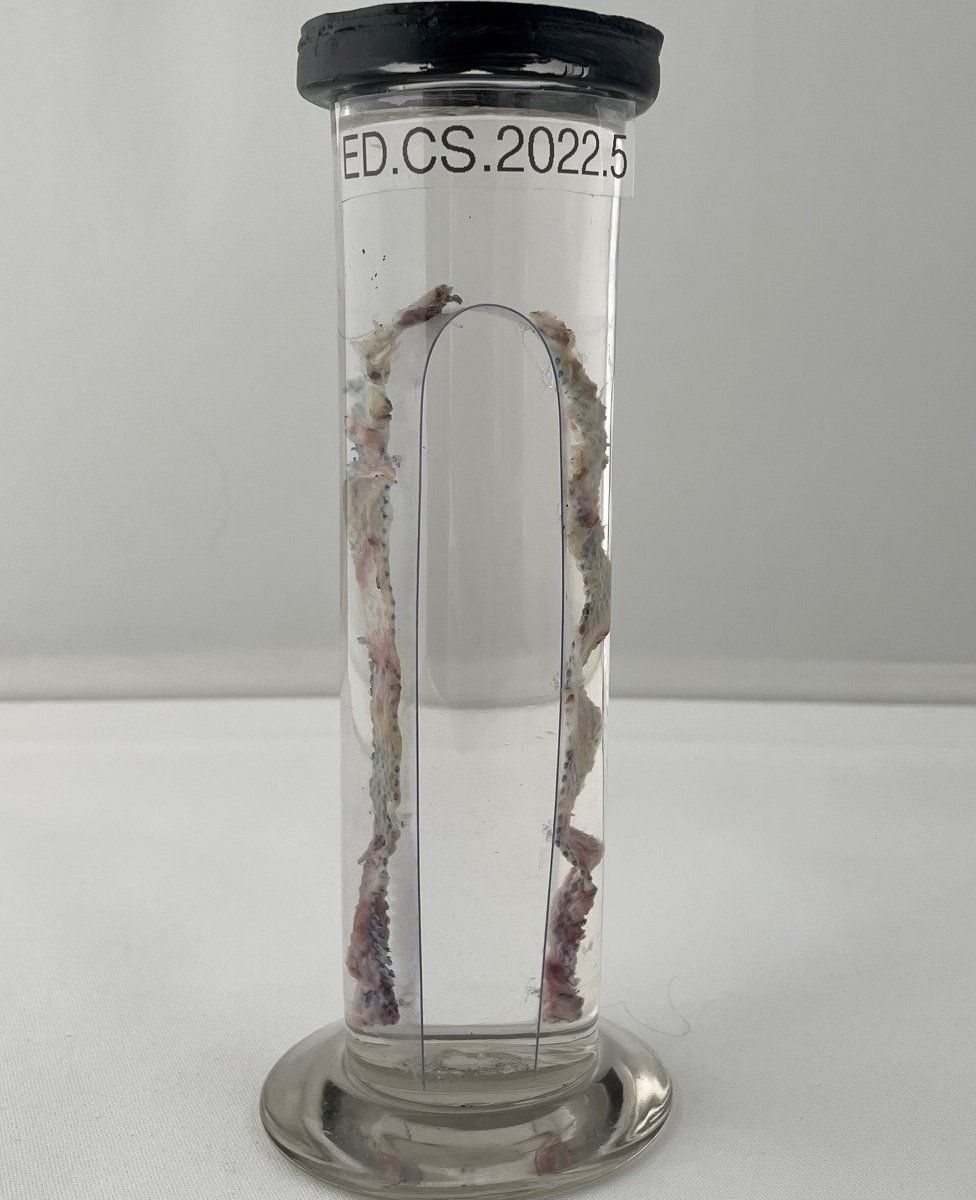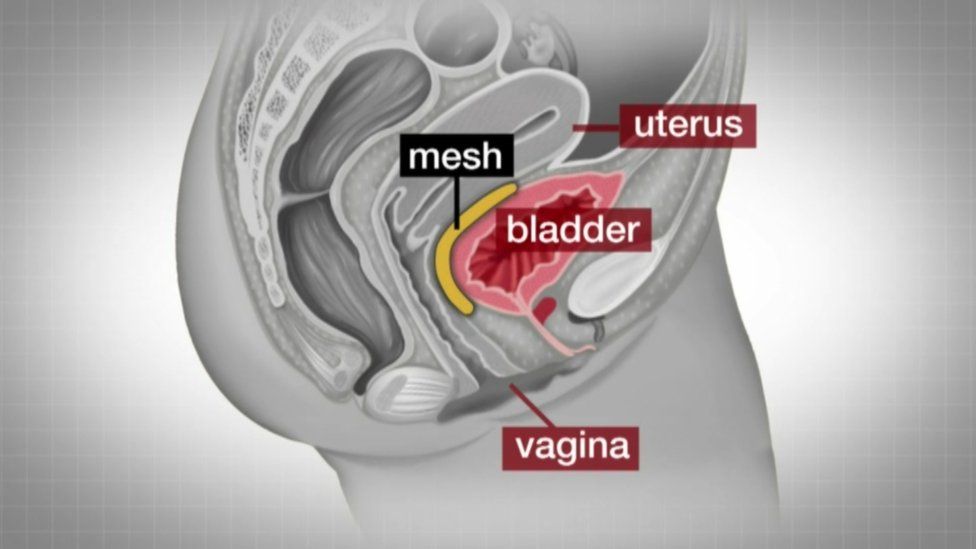Lisa Megginson had her transvaginal mesh tape surgically removed after years of health problems.
This video can not be played
To play this video you need to enable JavaScript in your browser.
Lisa Megginson had her transvaginal mesh tape surgically removed in April after years of health problems and now she has taken the unusual step of donating it to a museum.
The 51-year-old said she was “overwhelmed” to see the removed mesh on display among glass jars containing human specimens dating back to the 18th century at the Surgeons’ Hall in Edinburgh.
“This is fantastic to see but it’s a horror story to me,” said Lisa, from Kinross.
“That little 25cm piece of plastic has devastated my life and my family’s lives,” she said.
“It’s not just like it’s removed and you’re ok, I have still got a surgical journey to go on and you never recover.”
The Surgeons’ Hall Museums has not taken any new human remain specimens since the 1990s, but decided to make an exception to highlight what it calls a “significant period in women’s health”.

Mesh implants had been used to treat conditions some women suffer after childbirth, such as incontinence and prolapse.
But its use was stopped in Scotland after hundreds of women were left with painful, life-changing side effects.
The NHS has currently paused the technique in the UK unless no other option is suitable.
There is still not a clear idea of how many women experience complications, but there have been serious questions surrounding the introduction and promotion of the procedure.
Lisa approached the museum ahead of her surgery to see if it could form part of their collection.


“I just thought – it can’t just be they can take the mesh out of me and that’s it,” she said.
“I would hate to think it’s just somewhere on a shelf in a lab or it was disposed of. I thought somebody needs to see the explanted mesh.
“You know women will request their medical records and they will get a photograph but it’s not as powerful as physically seeing it.”
The Surgeons’ Hall have put the mesh on display in the Wohl Pathology museum.
“We haven’t accepted a new human tissue specimen in about 20 years because the collections have changed in their use,” said Louise Wilkie, curator of the museum.
“However we have made this exception for Lisa because it’s such a unique specimen, it represents a significant period in the history of medicine and allows us to tell that story, without the specimen we can’t really tell the story.
“I think this is the first time in the museum’s history that we’ve had a specimen donated directly from a patient and what that allows us to do is tell a much more personal narrative.”

What are mesh implants?

- The mesh, usually made from synthetic polypropylene, is intended to repair damaged or weakened tissue
- Over 20 years, more than 100,000 women across the UK – including more than 20,000 in Scotland – had transvaginal mesh implants. They are used to treat pelvic organ prolapse (POP) and stress urinary incontinence (SUI), often after childbirth.
- While the vast majority suffer no side effects, the use of mesh in Scotland was suspended except in “exceptional circumstances” in 2014 after it emerged some women suffered painful side effects
- Use of the procedure was halted in 2018
- Once the mesh is implanted, it is very difficult to remove

Stress urinary incontinence
Lisa had the mesh implanted in 2006. It was tension-free vaginal tape (TVT), a type of mesh used for stress urinary incontinence (SUI).
She had initially gone to the doctor about an over-active bladder but was advised that because she had four children she did have some SUI and the mesh would help.
“Obviously you trust these clinicians, you listen to these clinicians and I kept being told it was gold standard, so you think – this must be the best thing,” she said.
Lisa said she suffered a series of health problems but things got worse in 2017.
“I’d fallen off a chair in my office and I felt an almighty tear in my pelvis and within two weeks of that happening I lost all of my body hair,” she said.
Medics have never made a link between the mesh and her hair loss.


“It was hard because that’s when I lost myself,” Lisa said.
“That’s probably when a good bit of me died.
“Not only did I not feel like myself, I now didn’t look like myself, so that was very hard and it still is.”
It was only when she saw a television report on the ‘Sling the Mesh’ campaign the following year that she realised many other women were also suffering complications.
She was referred for treatment in 2018 but waited more than three years to have the mesh removed at Southmeade Hospital in Bristol, where she took the unusual step of choosing to have the surgery awake.
Lisa said: “It was a trust thing, it was a need to know and it was a closure thing, there were so many elements to it. But what I should add – it’s not for the faint-hearted.”

Lisa now advocates for others affected by mesh complications and is campaigning for women to get the treatment of their choice more quickly.
“I want to be there for other women, because a lot of women have been there for me and I want to continue the fight because there are still so many things that need to be done,” she said.
In the meantime, she hopes her mesh will raise awareness.
“Seeing my mesh here in the museum, I hope it empowers people,” she said.
“I hope clinicians come in and have a look at it. I hope researchers can use it as well, because that’s important.
“Researchers need to come in and have a look and read through a medical file and see what happened, where did things go wrong.
“It’s just one of those things – a medical device can go seriously wrong and have horrific effects on the human body.”